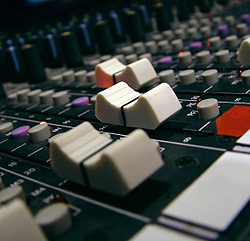
Signal then goes to the master fader where the overall level of all the signals is controlled with one fader. Signal then goes through the output stage of the console circuitry, and then to a connector/cable on the back of the console, where it’s fed to the input of the power amplifier(s), for example.
That’s the main path through any console. No matter how expensive, that’s it. But we still need some more information on how the controls interrelate, so look back at the signal flow diagram and note that right after the mic preamp, but before the EQ, there is a pickoff point. Think of it as a side road on your map.
The path drops down to a control I’ve labeled auxiliary 1. Follow the signal path down, and you’ll see that it comes in contact with the aux 1 bus. This is basically a piece of wire that runs from one side of the console to the other.
Signal then flows on to the right to the aux 1 master control, which controls the overall level of all the signals fed to the aux 1 bus.
The Fade Route
Let’s imagine for a moment that we’re using aux 1 to feed a set of stage monitors. We’re looking at channel 5 that is the lead vocal mic, and aux 1 feeds the lead vocalist’s stage monitors.
If you were to make an adjustment to the EQ on channel 5, would that change be heard in the vocalist’s monitor mix? No, because the feed for the monitor mix is picked off before the EQ.
If making adjustment to the lead vocalist’s channel fader, would that change be heard in the vocal monitors? No. We’re using what is known as a “pre-fade” auxiliary send, because the signal is picked off before the fader. It also happens that the signal is picked off before the EQ as well, but the proper term is “pre-fade”.
But what if we make a change to the mic trim on channel 5? Yes, because it’s upstream in the main path, changing the setting of the mic trim would affect the signal to both the main path and the auxiliary send.
This relationship is usually the preferred setup for mixing monitors. Most vocalists and musicians prefer that once their monitor mix has been established during soundcheck and rehearsal, that their mix not change during the course of the worship set (or show) unless they specifically request it. Unexpected changes in the mix can be very distracting.
Just past the fader is another pickoff point that goes to a control labeled auxiliary 2. As before, this also drops down to an aux #2 bus and its related master control. In this case, let’s imagine that the aux 2 output on the back of the console is patched to the input of a reverb unit sitting in an equipment rack next to the console.
In order to hear the reverb, the output of the reverb device is connected to a line level input on the console called the auxiliary return. We establish our dry-to-wet ratio by adjusting the send on aux 2 of channel 5, and of course the return level of the reverb unit is adjusted with the aux return.
